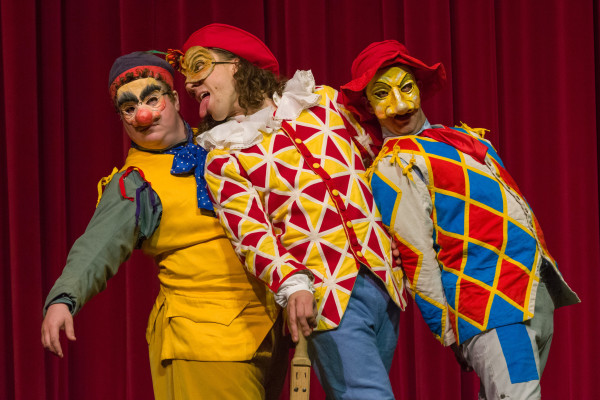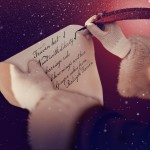
Looking for a good swordfight? Live original music? Some belly laughs? A naval battle? Perhaps a giant fish? Look no further, because there’s a new clown in town.
Three, actually. Harlequin, Clodpole, and Cotton debut on the Kimball Theatre stage next week in a brand new holiday production as zany as any you’ve seen. There are ten shows from Dec. 17 to Dec. 30.
The show is Harlequin’s Holiday, and it is part of a noble, if wacky, lineage that includes vaudeville, the Three Stooges, and Bugs Bunny. But it’s Blue Man Group that director Brandon Bruce says is the most accurate modern comparison. “They’re putting on a mask when they paint their face blue,” he says. “They’re clowns, too.” (But with plenty of technology.)
The form of entertainment is called a “harlequinade,” a distinctly English take on the Italian commedia dell’arte. It’s a style of entertainment that features acrobatics, music, and plenty of slapstick comedy.
The harlequinade was actually a lowbrow entertainment of the 18th century, but it was wildly popular. It was performed even at London’s Drury Lane and other respectable theaters. But the shows weren’t typically the main event. Instead, they were “afterpieces” of longer theater performances. In that day, the entertainments went on for many hours, more like going to the movies in the days before television, when theaters would show shorts and newsreels alongside features.
The harlequinade was a pantomime. “For some reason when commedia dell’arte moved over into England in the late 17th century, it became silent,” says Brandon. That’s why you won’t hear the three main clowns in this production speak.
The heyday of pantomime was the 1720s and 1730s in London, when a man named John Rich gained renown in the role of Harlequin. It was almost certainly performed at times in Williamsburg, but since they weren’t written down in the manner of Shakespeare’s plays, the record is thin. Names of specific performances are hard to find. Typically a notice would say that a pantomime would follow the show. Theater audiences knew what that meant.
Detailed descriptions of what went into one of these productions are even more unusual, but Brandon found one from the late 1700s called Harlequin’s Museum that informed and inspired the writing of Harlequin’s Holiday.
Brandon has hewed closely to the kinds of scenarios 18th-century audiences would have seen. That’s why, for example, a scene built around a surgery was scrapped. The assumptions about what surgery was and what could make a situation funny were just too different 200-plus years later.
Harlequin (pictured below), perhaps the most recurring character in Western comic theater, comes from “Arlecchino” in the commedia dell’arte. He’s the trickster, easily recognizable with his motley and slap-stick, who is always undermining authority with his mischief. There’s often some kind of magic involved, even if it’s just the ability to transform into an animal, object, or into a woman or man (there are accounts of women portraying Harlequin, as well). And he’s most often in the role of a servant.
Harlequin’s not a bad person, he just wants what he wants, whether it’s food, love, or just to be left alone. “That desire for freedom is what makes Bugs Bunny such a classic American harlequin.”
Clodpole, as you might guess from his name, is a bit… slow-witted. His character is drawn from one used in 18th-century English theater in particular. Unprepared for any situation, he’s always back on his heels, flailing, trying to find his balance. He struggles; he’s distracted. Think of Larry in the Three Stooges. He’s at left below.
Cotton, at right below, has a number of influences, most prominently “Il dottore,” the doctor, another classic stock character. He is seemingly always lumbering around on his tippy-toes, and a sweet person.
Between the improvisation, encores, and audience interaction, there will be something new happening every night. “Every night,” says Brandon “the audience is going to make the show they want to see.”
The full 18th-century theater experience means audience participation. In those days the audience area wasn’t darkened. People came and went. And they told the actors just what they thought.
So come early for the sing-along, and don’t worry about being bored. Don’t expect the show to be logical. And by all means, do not behave yourself.
To hear the cast talk about the program, click here for the latest Past and Present podcast, hosted by Rachel West.
Our thanks to Colonial Williamsburg photographer Dave Doody for the wonderful pictures in this post!




I love live theatre. Can’t wait to see this colorful comical production.